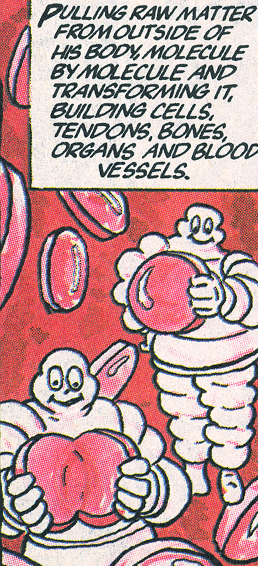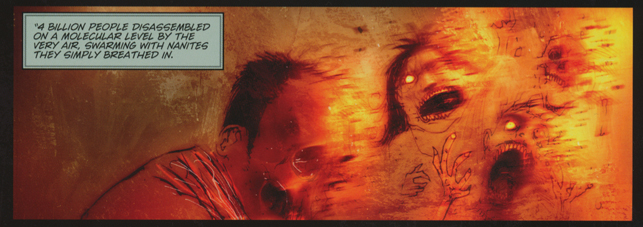It may come as no surprise, then, that comic books have been branded as children’s play, largely due to their fantastic content. Although there was a slight movement to embrace comics in the 1940s, academics have largely turned their collective nose up at the idea of studying comics. Today, however, social scientists are beginning to realize the wealth of information stored in these pictorial narratives.
In a fast-pace modern culture where religion plays a decreasing role, comics are contemporary versions of our culture’s mythology. They embody collective values and reflect public perception. They cultivate belief systems in readers. So what do comics have to do with nanotechnology?
Scientists have been pitifully negligent at considering public opinion when introducing new technologies. While genetically engineered food offers to solve the world’s hunger issues, many boycott it. Stem cell research promises to erase many major diseases from existence, yet certain segments of society cringe at the mere expression of those words. What has gone wrong here? Where is the disconnect between the scientific community and the masses?
The disconnect lies, at least partially, in the refusal of scientific and political communities to appreciate the mythos that have developed around certain scientific concepts in popular culture. If they fail to take these public beliefs into account, they cannot confront misconceptions head on. When policy-makers and science-enthusiasts decide they finally want to listen to public fears, anxieties, hopes and dreams about scientific concepts, they have to look no further than the local comic book shop.
Nanotechnology promises to revolutionize the way we live. Incurable diseases will become curable. Our clothing will become responsive to environmental conditions. (Try Google searching smart fabrics.) But nanotech will only reach its fullest potential if the public welcomes it.
According to comic books, the public warmly welcomed nanotechnology in the 1990s. Superheroes were equipping their suits of armor with nanotech, often blurring the boundary between man and machine to fight crime and make the world a better place. Characters were being injected with nanites, leading to extraordinary abilities such as strength, wisdom and immortality.

Figure 1. Image from Xombi #1 published in 1994. The
nanomachines are hard at work repairing damaged tissues.
Around the year 2000, however, nanotechnology veered off to a darker, scarier place in the comic book world. Nanites now traveled to Earth and caused the apocalypse; Superman was nearly killed when a nanobot harboring kryptonite was planted in his body. A nano-chip designed to cure Alzheimer’s disease accidentally brought corpses back to life, and turned them into flesh-eating zombies. Oops!

Figure 2. Image from Singularity 7 #1 published in 2004. The nanites disintegrate organic material, including humans, leading to the end of the world as we know it.
What was it about the turn of the century that brought these frightening portrayals of nanotechnology into pop culture?
There is evidence that the American public is generally becoming fearful of the accelerated rate of technological progress. Y2K threatened an unprecedented breakdown of our otherwise secure computer systems. Global warming forced everyone to reevaluate the consequences of our technological conveniences. This apprehension, coupled with deteriorating science and math programs around the country, make for a dangerously uninformed and panicked public.
Comic books can show scientists how the public will react (or is reacting) to the wondrous creations nanotechnologies promise to bring. Current comic books suggest the masses are in a feverish state of fear regarding nanotechnology. Scientists and policy makers cannot afford to ignore this, as they have with other past technological breakthroughs, or else we risk one of the most important scientific movements of the 21st century.





